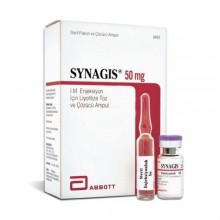



Palivizumab is a humanized monoclonal antibody IgG1 tothat interact with the epitope A of the fusion protein antigen (protein F) of the respiratory syncytial virus (RSV). Palivizumab molecule consists of human (95%) and mouse (5%) sequences.
Palivizumab exhibits a pronounced neutralizing and inhibiting effect on fusion proteins of PCV strains of subtypes A and B.
Palivizumab at a plasma concentration of cotton rats of about 30 μg / ml reduces PCV replication by 99%.
Prevention of complications in the form of serious lower respiratory tract diseases caused by respiratory syncytial infection (RSI) during the epidemiological season of RSI in children with a high risk of developing RSV-disease:
1 fl. contains palivizumab 50 mg.
No customer reviews for the moment.
Synagis is injected into the / m, preferably in the outer lateral region of the thigh. Gluteus muscle should not be used frequently for injection because of the risk of damage to the sciatic nerve. Injection should be carried out under standard aseptic conditions. If the volume of the dose exceeds 1 ml, the drug is administered in several places.
A single dose of the drug is 15 mg / kg body weight. The scheme of use consists of 5 injections of the drug, carried out with an interval of 1 month during the seasonal rise in the incidence caused by a respiratory syncytial virus. Preferably, the first injection was made before the onset of incidence. The advantages of a more prolonged use of the drug have not been established. Children who have been infected with RSV during the use of Synagis are advised to continue using it every month throughout the rise in incidence in order to reduce the risk of reinfection.
When conducting research on the use of the drug for prophylactic purposes, the adverse reactions in children in the control group and in the group of children who received the drug were similar. Adverse reactions were transient, and their severity ranged from mild to moderate.
Often (≥ 1%, <10%) were noted: an increase in body temperature, reactions at the injection site, nervousness.
The following adverse reactions have been reported infrequently (≥ 0.1%, <1%).
On the part of the respiratory system:upper respiratory infections, runny nose, cough, sneezing.
From the hemopoietic system: leukopenia.
On the part of the skin: rash.
From the digestive system:diarrhea, vomiting.
Other: abnormal liver tests, viral infection, pain, increased AST, ALT.
There were no clinically significant differences in adverse reactions in studies of the prevention of infections caused by RSV in premature babies and children with bronchopulmonary dysplasia, as well as in the examined subgroups of children differing by clinical category, gender, age, intrauterine development, and country of residence , racial or ethnic origin, or serum palivizumab concentrations.
There were no clinically significant differences in the safety profile between children, without acute RSV infection and those who were hospitalized with the specified diagnosis.
Abolition of palivizumab due to the development of adverse reactions was rare (0.3%). The number of deaths was approximately equal in the groups of children who were prescribed palivizumab or placebo (0.4% and 1%, respectively); there was no connection with the administration of the drug.
Post-marketing observations
Rarely (> 0.01%, <0.1%) apnea was noted.
Extremely rare (<0.01%) anaphylaxis and urticaria were noted.
The formation of anti-antibodies to human immunoglobulins
In a clinical study, it was found that during the first course of therapy with Synagis, in 1% of cases, antibodies specific to palivizumab and characterized by low titer are formed. During the second course of therapy, 55 of 56 children did not detect antibodies, including two cases of antibody detection during the first course. Therefore, the formation of antibodies is temporary and has no clinical significance. In studies on children with congenital heart disease, the antigenic activity of the drug has not been studied.
Hypersensitivity to palivizumab or to one of the excipients or to other human monoclonal antibodies.
Studies on the interaction of palivizumab with other drugs have not been conducted, and therefore there is still no data on such an interaction. In a clinical phase III study, premature babies and children with bronchopulmonary dysplasia received palivizumab along with vaccines for the prevention of childhood infections, influenza vaccine, bronchodilators and corticosteroids.There was no increase in the incidence of adverse reactions among children who received these drugs. Since monoclonal antibodies are specific only for RSV, it is assumed that palivizumab should not inhibit the development of immunity during vaccination.
The introduction of the drug Synagis may be accompanied by allergic reactions of the immediate type, including anaphylactic, therefore patients should be under medical supervision for at least 30 minutes, and the room in which the drug is administered must be provided with anti-shock therapy.
A moderate or severe acute infectious disease or febrile condition may be the reason for delaying the initiation of the use of the drug Sinagis, unless, in the opinion of the doctor, refusal of the drug does not represent a greater risk. A mild fever, such as a mild infection of the upper respiratory tract, is not a reason for delaying the administration of the drug Synagis.
As with any intramuscular injections, Synagis should be administered with caution to patients with thrombocytopenia or blood clotting disorders.
In the three cases of overdose with Synagis (20.25 mg / kg, 21.1 mg / kg and 22.27 mg / kg) that occurred, there were no adverse events.
Studies and clinical trials of Palivizumab (Click to expand)